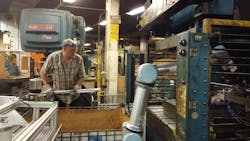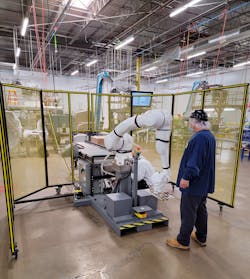Formic's Misa Ilkhechi discusses industrial robotic integration
Misa Ilkhechi is co-founder and vice president of sales at Formic. He leads the product vision, strategy and roadmap for a flexible and affordable robot-as-a-service offering that democratizes access to automation for factories of any size. With more than 10 years of experience in automation, robotics and business development, he answered our questions about the future of robotic integration.
As industrial robot installations continue to rise, they continue to be integrated into work cells for palletizing, machine tending, welding and other industrial applications. What innovative or efficient robot-integration applications have you seen or been involved with?
Misa Ilkhechi; co-founder and vice president of sales, Formic: As the momentum of robotic integration accelerates, we at Formic have been deeply involved in optimizing robot cell configurations. Our approach has been rooted in the principles of standardization and modularization of robot cell designs, facilitating rapid deployment across various industrial applications.
By embracing the latest software methodologies, we've been able to enhance the configurability and management of these cells, streamlining recipe creation through a user-centric graphical user interface (GUI). This not only expedites the setup process, but also empowers users, even those new to automation, to tweak and manage cell operations with precision.
To further support this, we've compiled a rich library of video-based documentation, providing clear, step-by-step technical guidance on troubleshooting and optimization. Our focus remains steadfast: to ensure fast, simple integration of robot cells, driven by technical excellence and user accessibility.
What have been the biggest improvements to robot integration and interoperability with other robots or components in work cells in the past five years?
These unified interfaces play a pivotal role in streamlining integration processes and ensuring seamless communication between robots and other cell components. Additionally, there's been a noticeable surge in the development and adoption of robot-operating-system (ROS) libraries. This open-source approach promotes a collaborative ecosystem, allowing for the rapid exchange of innovations and ensuring that robotic systems can operate harmoniously within diverse work cell configurations.
Can you explain how software or open-source control architectures have changed robotic integration?
Misa Ilkhechi; co-founder and vice president of sales, Formic: Over the past decade, the rise of software-centric and open-source control architectures has fundamentally reshaped the landscape of robotic integration. Traditional proprietary systems, while effective, often posed challenges in terms of flexibility and adaptability. Open-source control architectures, on the other hand, have ushered in an era of unprecedented collaboration and innovation.
With platforms like ROS leading the charge, developers and engineers across the globe have been able to contribute to and leverage a collective pool of knowledge. This collaborative approach has accelerated the development of sophisticated algorithms, sensor integrations and motion-planning techniques.
Moreover, these open architectures promote modularity. This means that robotic systems can be more easily customized to suit specific applications or integrated with new technologies as they emerge. The transparency of open source also ensures that any issues or vulnerabilities are quickly identified and addressed by the community, leading to more robust and reliable robotic solutions.
Lastly, from a software perspective, the shift toward more intuitive graphical interfaces and simulation-based environments has democratized access. Even individuals with minimal coding experience can now design, test and deploy robotic workflows with relative ease, thereby expanding the potential for robotic applications across various industries.
As manufacturers and warehouses/distribution centers push toward autonomous operations, what is the benefit of collaborative robots (cobots) and their ability to work alongside humans?
Misa Ilkhechi; co-founder and vice president of sales, Formic: Collaborative robots, or cobots, represent a paradigm shift in the robotics domain, particularly with the growing emphasis on autonomous operations in the manufacturing and distribution sectors. One of the primary advantages of cobots is their intrinsic design philosophy, which emphasizes human-robot collaboration (Figure 1).
Moreover, their lightweight design and compact footprint render cobots uniquely suited for mobile applications. This mobility advantage means they can be rapidly deployed across different zones within a facility, offering unprecedented flexibility. Whether it's adapting to changing production schedules, addressing bottlenecks or being redeployed for varied tasks, cobots stand out as agile and versatile assets in modern production environments.
In essence, cobots not only bridge the gap between fully manual and fully automated processes, but also usher in an era where the agility of human ingenuity and the precision of robotics converge for unparalleled operational efficiency.
When will robotics technology become user-friendly enough that integration, installation and operation is plug-and-play and no longer requires extensive engineering?
Misa Ilkhechi; co-founder and vice president of sales, Formic: The trajectory of robotics technology is indeed moving toward a more user-centric approach, and we are already witnessing the early stages of this transformation. A noticeable shift toward standardization of designs across the industry is indicative of the collective push for more universally accessible robotic solutions. Numerous solution providers are vigorously working on creating plug-and-play systems, aiming to minimize the intricate engineering traditionally associated with robotic deployment. Formic offers systems from beRobox and THG Automation, for example, that can be customized for a manufacturer's products and start producing for the operation within one hour of delivery.
A significant catalyst in this evolution has been the reduction in costs associated with cameras, sensors and computational hardware. As these components become more affordable, they are being integrated more extensively into robotic cells. This abundance of sensory data is enabling robots to have a richer understanding of their environment, thus reducing the reliance on static, rigid setups. The enhanced feedback loop provided by these sensors allows for dynamic adjustments and real-time decision-making. This means that instead of relying on fixed, inflexible mechanical fixtures, modern robotic systems can adapt on the fly, making them more versatile and accommodating to changes.
In essence, the convergence of affordability, advanced sensing and standardization is steering the industry toward a future where robotic integration is streamlined, flexible and more intuitive than ever before.
What future innovations will impact the integration of robotics technology in work cells and with other industrial machinery?
Misa Ilkhechi; co-founder and vice president of sales, Formic: Advanced artificial intelligence (AI) and machine learning: As AI algorithms become more refined, robots will possess enhanced decision-making capabilities, allowing them to autonomously adapt to unforeseen challenges in work cells. This will reduce downtime and increase operational efficiency.
Enhanced sensor fusion: The integration of a diverse array of sensors will provide robots with a richer perception of the environment. This, in tandem with AI, will enable them to perform tasks with higher precision and safety.
5G and Internet of Things (IoT) integration: The rollout of 5G networks will facilitate faster and more reliable communication between robots and other machinery. Combined with the Internet of Things, this will usher in an era of truly interconnected industrial ecosystems where data is shared seamlessly.
Flexible and modular robotic systems: Future robotic systems will be designed with modularity in mind, allowing for quick reconfiguration of work cells to meet evolving production demands without major overhauls.
Human-robot collaboration enhancements: Advancements in soft robotics and tactile sensing will make human-robot interactions even safer and more intuitive. This will further solidify the role of collaborative robots in industrial settings.
Tell us about your company’s state-of-the-art robotic integration into a work cell or transporting materials/goods between cells.
Misa Ilkhechi; co-founder and vice president of sales, Formic: At Formic, we are at the forefront of revolutionizing end-of-line material handling processes with a unique end-to-end service, including everything from upfront production analysis and broad partner-based solutions to ongoing monitoring and maintenance. Our expertise spans diverse domains, including packaging, plastic injection molding and machine tending for equipment like lathes, mills and press brakes.
Recognizing the industry's shift toward autonomous solutions, we have strategically integrated advanced mobile robotic systems into our offerings. Specifically, we've collaborated with renowned robotics manufacturers like MiR and Otto, leveraging their state-of-the-art autonomous mobile robots (AMRs) and autonomous forklifts. These collaborations empower manufacturers to overcome material-handling challenges with unparalleled efficiency and precision, ensuring streamlined operations and enhanced productivity.
About the Author
Mike Bacidore
Editor in Chief
Mike Bacidore is chief editor of Control Design and has been an integral part of the Endeavor Business Media editorial team since 2007. Previously, he was editorial director at Hughes Communications and a portfolio manager of the human resources and labor law areas at Wolters Kluwer. Bacidore holds a BA from the University of Illinois and an MBA from Lake Forest Graduate School of Management. He is an award-winning columnist, earning multiple regional and national awards from the American Society of Business Publication Editors. He may be reached at [email protected]

Leaders relevant to this article:




